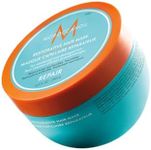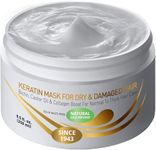Buying Guide for the Best Hair Repair Masks
Choosing the right hair repair mask can make a significant difference in the health and appearance of your hair. Hair repair masks are designed to nourish, strengthen, and restore damaged hair, making them an essential part of your hair care routine if you have issues like dryness, breakage, or split ends. When selecting a hair repair mask, it's important to consider your specific hair type and the particular issues you want to address. Understanding the key specifications of hair repair masks will help you make an informed decision that best suits your needs.IngredientsIngredients are the active components in a hair repair mask that determine its effectiveness. They are crucial because they directly impact how well the mask can repair and nourish your hair. Common beneficial ingredients include keratin, proteins, oils (like argan or coconut), and vitamins. If your hair is extremely damaged, look for masks with proteins and keratin to strengthen and rebuild hair structure. For dry hair, masks with oils and moisturizing agents are ideal. Always consider any allergies or sensitivities you might have to certain ingredients.
Hair Type CompatibilityHair type compatibility refers to how well a hair repair mask works with different hair textures and conditions. This is important because a mask that works wonders for curly hair might not be as effective for straight hair, and vice versa. Masks are often labeled for specific hair types such as fine, thick, curly, or color-treated. If you have fine hair, opt for a lightweight mask that won't weigh your hair down. For thick or curly hair, a richer, more hydrating mask might be necessary. Always choose a mask that aligns with your hair type for optimal results.
PurposeThe purpose of a hair repair mask is the specific hair issue it is designed to address, such as hydration, strengthening, or color protection. This is important because it helps you target the exact problem you're facing with your hair. If your hair is brittle and prone to breakage, look for masks that focus on strengthening and repairing. For color-treated hair, choose masks that offer color protection and hydration. Understanding the primary purpose of the mask will guide you to the right product for your hair's needs.
Application TimeApplication time refers to how long you need to leave the mask on your hair for it to be effective. This is important because it affects how convenient the product is to use in your routine. Some masks require only a few minutes, while others might need to be left on for 20-30 minutes or even overnight. If you have a busy schedule, a quick-acting mask might be more suitable. However, if you have the time and your hair needs intensive treatment, a longer application time could be beneficial.
Frequency of UseFrequency of use indicates how often you should apply the hair repair mask to achieve the best results. This is important because overuse can lead to product buildup, while underuse might not provide the desired benefits. Some masks are designed for weekly use, while others can be used more frequently. If your hair is severely damaged, you might need to use the mask more often initially, then reduce frequency as your hair improves. Always follow the manufacturer's recommendations and adjust based on how your hair responds.

















